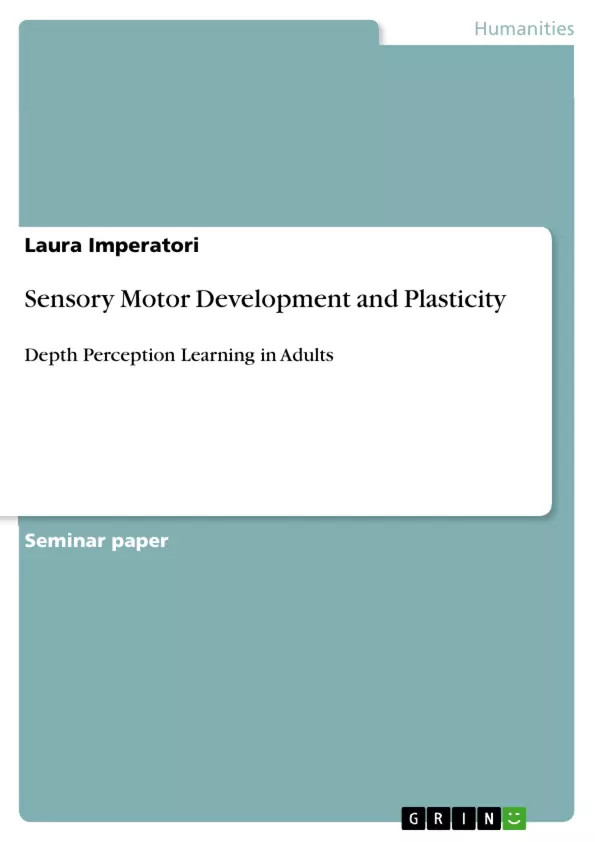Our aim was to confirm that vision in adults can be trained to associate certain retinal locations with specific depth arrangements of stimuli, such that presenting a depth-ambiguous stimulus at a certain retinal location would cause it to be perceived to have a specific depth arrangement. Even if Backus et al. have already demonstrated that "cue-recruitment" is still possible in human adults, i.e. that adults can still learn to associate any arbitrary stimulus feature with depth, we were not able to verify the hypothesis that our ability to perceive depth is not innate and - thus - purely a product of postnatal learning experience, whereby the capacity is still present in human adults. We verified that the 14 subjects could reliably report depth as a group, but they did not perceive, more than would be expected by chance, the same depth arrangement for an ambiguous stimulus at a particular location in the test block as they had for the unambiguous stimuli at that location in the training blocks. Hence, we rejected the first H_{0, training} hypothesis that there is no significant difference in the number of correct and incorrect answers during the training session, and furthermore, retained the second H_{0, test} hypothesis that there is no significant difference between the number of trials, in which a test block was perceived to be same or opposite to the previous training stimuli at the respective same location as in the training trials, since the paired t-test gave rise to t(13)_{0.05}=0.2 , which is well below the expected value for a one-tailed t-test of 1.7.
Inhaltsverzeichnis (Table of Contents)
- Introduction
- Methods
- Results
- Discussion
- Conclusion
- References
Zielsetzung und Themenschwerpunkte (Objectives and Key Themes)
The primary objective of this study was to investigate the possibility of training adults to associate specific retinal locations with depth arrangements of stimuli. The study sought to confirm that vision in adults can be modified by associating certain retinal locations with specific depth arrangements, allowing for the perception of depth even in ambiguous stimuli.
- Depth perception learning in adults
- Influence of training on visual perception
- The role of retinal location in depth perception
- Association learning and its effects on visual perception
- The limitations of depth perception training in adults
Zusammenfassung der Kapitel (Chapter Summaries)
- Introduction: This chapter discusses the classical debate in psychology regarding the role of biological predisposition versus postnatal experience in shaping our perception of the world. It examines the existing research on depth perception in infants using the "visual cliff" paradigm, highlighting the evidence for the ability of infants to learn depth cues. The chapter introduces the study's aim to investigate whether this ability to learn new depth cues is still present in adults, building on the findings of Backus et al. (2013) who showed that adults can learn to associate arbitrary stimuli with depth.
- Methods: This chapter details the experimental design employed in the study. It outlines the training procedure involving depth discrimination tasks with 3 blocks of 60 trials, focusing on the association of specific retinal locations (above or below fixation) with depth cues. The chapter further describes the test block where ambiguous stimuli were presented to one eye, lacking binocular disparity, and assesses participants' ability to perceive depth based on the previously learned association. Finally, the chapter details the statistical analysis methods used to evaluate the results, involving paired one-tailed samples t-tests.
- Results: This chapter presents the findings of the study. The results demonstrate that the 14 participants, who reported experiencing depth perception during the training trials, were able to reliably report the depth arrangement of stimuli presented in the training blocks. However, the analysis did not find significant evidence to support the hypothesis that participants would perceive the same depth arrangement for ambiguous stimuli in the test block as they had for unambiguous stimuli during training.
- Discussion: This chapter analyzes the limitations of the study and potential explanations for the findings. It considers factors such as the two-alternative forced choice design of the test block, the relatively low number of participants who reported perceiving depth in the training trials, and the potential confusion caused by the constant switch in the question format.
Schlüsselwörter (Keywords)
Depth perception, visual perception, retinal location, training, association learning, adults, ambiguous stimuli, binocular disparity, visual cliff, cue recruitment.
- Arbeit zitieren
- Laura Imperatori (Autor:in), 2014, Sensory Motor Development and Plasticity, München, GRIN Verlag, https://www.grin.com/document/276479



